After 16 days working 16 hours a day, Medford, Ore., Local 659 member Colin Farrell took a break to make a phone call.

|
Smoke from the fires could be seen 3,000 miles away in New York and Washington, and close to the fires, like this picture taken by Grand Rapids, Mich., Local 876 traveler Rob DeLeon in Oroville, Calif., the smoke made working conditions beautiful if dangerous and uncomfortable.
Photo courtesy: Rob DeLeon
|
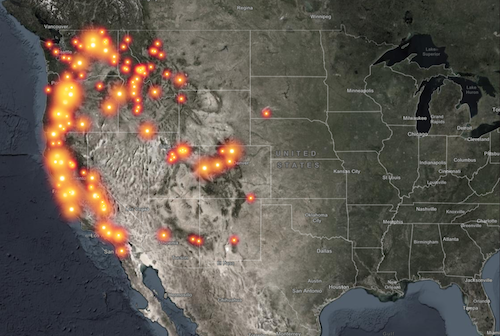
|
At one point in early September, dozens of fires were ravaging the West including five of the six largest fires in California history
Photo Courtesy FireWeatherAvalanche.com
|

|
Response crews have many jobs in fire seasons from shutting power off to prevent down lines from starting fires or blocking evacuation routes to replacing damaged grid assets to upgrading and fire hardening but the most important job Local 1245 Business Manager is reminding this PGE crew, is coming home safe.
Photo Courtesy: Local 1245/John Storey
|

|
IBEW lineworkers, clerical workers,
tree trimmers, traffic controllers,
warehouse workers and more worked
around the clock weeks on end.
Credit: Local 1245/John Storey
|
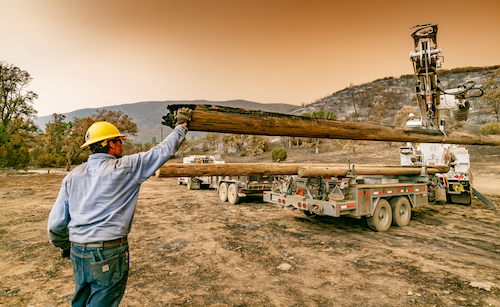
|
Conditions after a a fire are some of the most difficult faced by IBEW lineworkers. It’s always hot, the air is thick with smoke, ash gets everywhere and there is always the risk that a fire erupts again far from the front. Of all first responders, the IBEW stays the longest.
Photo Courtesy - Local 1245/John Storey
|
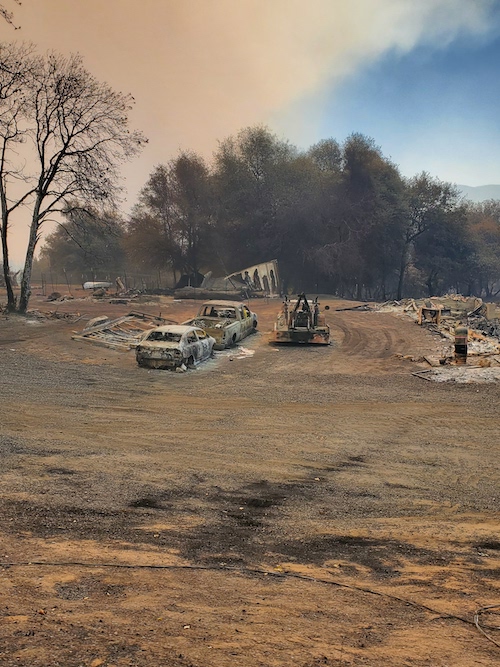
|
Working day after day in devastated communities is sometimes harder than the physical toll said Ninth District International Vice President John O'Rourke.
Photo courtesy: Rob DeLeon
|
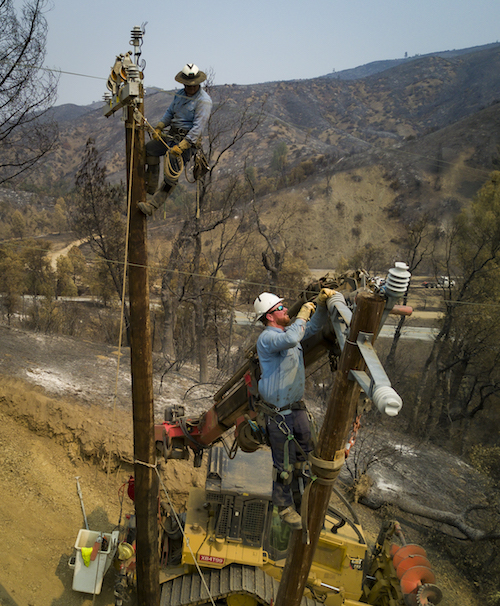
|
In California and Oregon, linemen —
like these PG&E workers from Local
1245 — not only replaced destroyed
poles and wires, they upgraded them,
surrounded by destruction.
Credit: Local 1245/John Storey
|
Less than 200 yards away, a small stand of trees in a charred field of ash stood burning. They were all that survived the flame front that had passed days ago destroying three towns along Interstate 5 and racing into the suburbs of Medford itself before being turned back.
Now, they too were burning.
"There's half an inch of ash on my truck every morning," he said. "It's like a black snowstorm; absolute devastation."
Farrell has been a lineman in Oregon for more than two decades. He just turned 61. His father, Charles, was a lineman for more than 40 years. Neither of them, he said, had seen anything like the ocean of fire burning from British Columbia clear down to the Mexican border.
No one has. And no one saw anything like the year before, or the year before that.
At one point this fall, five of the six largest fires in California history were burning. The sun over New York and Washington, D.C., was dimmed by the ashes of West Coast fires.
And everywhere that fire and people came together, there were IBEW members there to keep them safe, protect their connection to power and, where the fire tore through, to repair the damage.
Oregon
Labor Day weekend unleashed a windstorm that shattered forests across the West Coast.
The worst part of the windstorm wasn't the speeds, though; it was the direction. It wasn't coming from the west — the prevailing wind — the direction the 150, sometimes 200-foot-tall fir trees have grown to resist.
It mowed them down, said Portland Local 125 Business Manager Travis Eri.
"When the fire gets into the canopies, it makes its own windstorms and embers can be blown a half-mile ahead,' he said.
At the fires' peak, Local 659 Business Manager Mike Scarminach drove the length of his jurisdiction, from the California border to the Washington border, doing site visits, checking on his people.
He never saw the sun.
"It was surreal to have so many fires in so many different locations. It appeared that every community up I-5 was affected by fire," he said. "Generally, we have a weather event and it's isolated to a few communities. This was the whole state. I drove from one end of the state to the other and you never got out of the smoke."
Fire recovery happens in terrible conditions. Everything that isn't ash or dirt is still smoldering and, if you have to use a helicopter to get there, it whips it all into the air.
At one point the air in Oregon was literally off-the-charts bad. The EPA's Air Quality Index measures five types of air pollution on a scale of one to 500. "Healthy" air gets a rating between 0 and 50. An AQI reading of 130 is dangerous, 301 or greater is considered hazardous.
In early September, the air in Oregon was above 700.
"Now put on a mask and run a marathon," Scarminach said. "We are blue-collar athletes in PPE."
California
There are no superlatives left for California's wildfires.
In the past, the state's worst wildfires have all come once the Santa Ana, Sundowner and Diablo winds began to blow in November and December. It was a record-setting disaster this year before the winds even started, 17 times worse than last year.
A single fire, the August Complex fire, destroyed nearly 1 million acres in September, the worst in state history, and it was not even half under control as October began.
"We have thousands of linemen working, thousands of tree trimmers working. It is wall-to-wall," said Vacaville, Calif., Local 1245 Business Manager Tom Dalzell.
California utilities are roughly split between San Diego Local 465 and Diamond Bar Local 47 in the south and Local 1245, which covers all of northern California.
In the past, Dalzell said, utility workers in firelands across the West Coast have done work in three main categories.
First, during fire emergencies, utility workers — both gas and electric — make the grid safe, often by shutting down parts of it. In California, for example, when winds get over 50 miles per hour, the utility selectively shuts down sections of the grid, and that is work done substation by substation. Utility workers will also keep evacuation routes clear and safe from downed poles and lines, moving ahead of even the fire, police and ambulance crews who must treat every downed wire as if it were live.
Next, after the fire passes, power must return. Poles must be replaced, miles of melted conductor restrung. And before power can be turned on, the entire deenergized area has to be visually inspected for a tree leaning against the cold wires, ready to start another round of fires.
Finally, there is the near endless maintenance work, like line clearance and tree trimming, which helps prevent damage that can cause more fires.
Supporting it all is the army of warehouse, clerical, support and fleet workers that make the line and gas work possible.
"They don't get the attention they deserve. Their jobs are often just as hot, just as difficult and the air is just as bad, and no one could do their jobs without them," Dalzell said.
In recent years, fire hardening has been a greater part of that maintenance work. Poles are replaced with wood, fiberglass or steel that is better able to survive a fire even before there is a failure. Many utilities have also been replacing traditional conductor with tree wire, protected by multiple layers of shielding.
"We put up poles that can hold up half the world in people's back yards," said Local 47 Business Manager and International Executive Council member Pat Lavin.
This year, there is a fourth, entirely new kind of work done by IBEW members. Local 1245 negotiated the creation of two new job classifications: Safety Infrastructure Protection Team Leads and Technicians. There are about 100 in total and, to a person, they have firefighting experience mainly from the state wildfire service CalFire or the Forest Service.
They travel wherever they are needed, spraying down utility infrastructure with pink flame-retardant spray, putting out fires where they find them with water from their trucks. And, unusually, they are authorized to fight fires off utility property when they find them.
SIPT Lead Ashton Aaron Hodge's own home burned to the ground, Dalzell said, but he and his team-member Trevor Dirksen fought for and protected the homes of his neighbors for five days, extinguishing flames on decks and porches while treating more than 1,300 poles in the CZU fire zone.
"We think he saved at least 17 homes," Dalzell said.
Sadly, there have been losses beyond just property.
Steve Wink, a troubleman and 37-year member of Local 1245 died working the LNU Complex Fire in Vacaville. According to preliminary reports, he was assisting first responders in the fire zone at the time of his death.
Mike Fournier, a pilot who left Edison but was only on honorary withdrawal at Local 47 and still a member, was killed when his helicopter crashed while fighting a fire south of Coalinga.
"Mike helped us organize the other helicopter pilots at Edison and they never let him forget it, so he left, but he didn't leave us," Lavin said.
Washington
The last state to be hit was Washington. Seattle Local 77 doesn't just cover Washington state, though. Its 8,000 members can be found from Washington's dark green coastal forests, across the Cascade mountains and into to the farmland of the Columbia Plateau, the panhandle of Idaho and the western reaches of Montana.
The driest part of the state gets only a few inches of rain each year while the western slopes of the Olympic peninsula can get nearly 12 feet. But it was the wet side of the state that suffered this year.
"This has been the worst year in three decades, and it came so early. All the leaves were still on the trees," said Local 77 Business Manager Rex Habner. "They are like kites. They go down, take a line or lightning strikes and the whole thing burns."
One fire started when a tree, well outside the right-of-way, fell and knocked over another tree, and then another until one breached and took down a line.
The east side wasn't spared either. Habner said more than 1,000 poles were burned in eastern Washington and Idaho.
"There is no right-of-way wide enough," Habner said. The federally run Bonneville Power Authority has 200 feet on either side of its massive transmission lines. It still isn't enough, he said. The only solution is hardening the grid and his state, he says, is far behind his neighbors.
"I love the trees. I don't want to clear-cut anything," he said.
It isn't enough to replace what fails, Habner said. California is proof of that. Worse, in the late 1990s, when Habner first took up the tools, there were 285 journeymen linemen in the 12 Washington counties served by Puget Sound Energy. Now there are 85 troublemen and a few dozen contractors. There is plenty of overtime in emergencies for the few who are left, Habner said, but the work to prevent emergencies doesn't get done.
Tacoma Local 483 Business Manager Alice Phillips represents an almost entirely urban jurisdiction that has been far from the fires. But she sees where it all leads.
"This all tracks back to the politics. We need infrastructure. We need funding to go in and harden and repair our power grid. It's more important than even roads and rails," she said. "Things are changing and changing fast. It's a mess."
The Emotional Toll
As October began, new fires erupted across the West even as many of the late-summer fires were only partially under control.
Convoys of bucket trucks rolled from fire to fire, like a hurricane response on the East Coast.
"People don't understand what goes into working these storms," said Ninth District International Vice President John O'Rourke. "The firemen are great, the police and EMS, but when the fire is done, they go home. We're still on the job, rebuilding in the same conditions — in the soot, the ash, the erosion."
O'Rourke said too often unspoken is the emotional toll of doing this work.
Of course, the conditions wear you down, the long hours, days that seem to go on for weeks. But there are rewards. The exhaustion and soreness at the end of each long day are paid back, in part at least, with the satisfaction that the work is honest and appreciated.
It isn't just poles and wires, but homes and communities IBEW members are rebuilding.
But, O'Rourke said, there is an often-unspoken reality that has to be acknowledged.
"The emotional impact of working in communities that are devastated, working with co-workers who lost homes and worrying about your own home and your own family is a crazy emotional triangle," he said.
That's true whether the job site is a back office or warehouse, on the road controlling traffic or above it all in a helicopter ferrying people and supplies where they are most needed.
"There is no higher calling than learning a difficult trade and then using it to provide for your family and build your community," O'Rourke said.
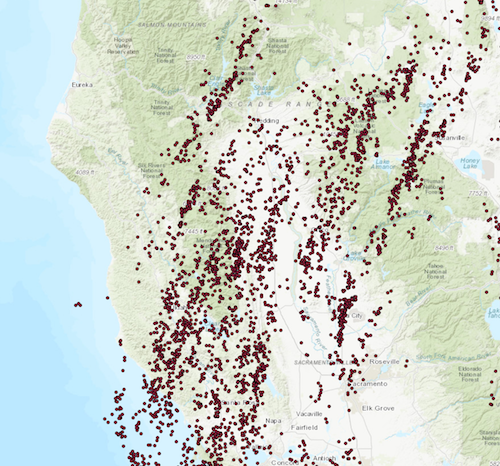
|
In late August, unprecedented dry lightning storms — more than 12,000 strikes over a few weeks — met record heat, unleashing five of the six largest wildfires in California history.
Source: CalFire
|
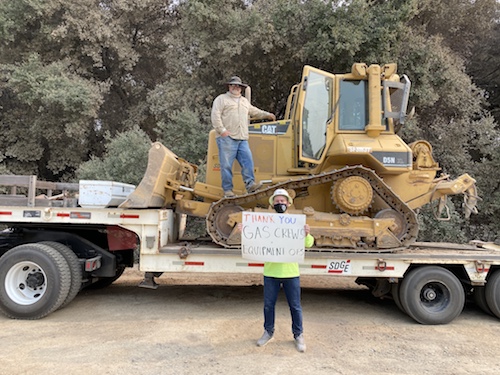
|
|
All utility workers played a part in the
crisis, including these San Diego
Local 465 gas workers.
|